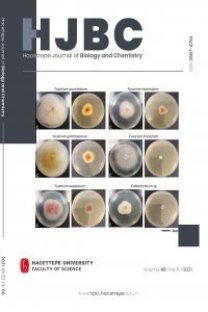Suspensiyon polimerizasyonu ile gözenekli ve gözeneksiz poli iso-bütil metakrilat mikrokürelerinin hazırlanması
Mikrokureler, gamma radyasyonu, poli izo-butil metakrilat, suspensiyon polimerizasyonu
Preparation of porous and non-porous poly iso-butyl methacrylate microspheres by suspension polymerization
___
- 1. J. Cejkova, F. Stepanek, Compartmentalized and internally structured particles for drug delivery - a review. Current Pharm. Design, 19 (2013) 6298.
- 2. M. Paulis, J.R. Leiza, Polymer/clay nanocomposites through emulsion and suspension polymerization. Advances in Polymer Nanocomposite Technology, ed. V. Mittal. (2010) 53-100.
- 3. D.R. Kryscio, Peppas, Critical review and perspective of macromolecularly imprinted polymers. Acta Biomater., 8 (2012) 461.
- 4. D.L. Elbert, Liquid-liquid two-phase systems for the production of porous hydrogels and hydrogel microspheres for biomedical applications: A tutorial review. Acta Biomater., 7 (2011) 31.
- 5. B.N. Kolarz, Reactive multiacrylic copolymers prepared by suspension polymerization. Polimery, 44 (1999) 637.
- 6. A. Nasser, U. Mingelgrin, Mechanochemistry: A review of surface reactions and environmental applications. Appl. Clay Sci., 67-68 (2012) 141.
- 7. T. Caykara, S.S. Alaslan, M. Gürü, H. Bodugoz, O. Güven. Preparation and characterization of poly(isobutyl methacrylate) microbeads with grafted amidoxime groups. Radiat. Phys. Chem., 76 (2007) 1569.
- 8. H. Bodugoz, O. Guven, The synthesis of nonporous poly(isobutyl methacrylate) microspheres by suspension polymerization technique and investigation of their swelling properties. J. Appl. Polym. Sci., 83 (2002) 349.
- 9. M.J. Zohuriaan-Mehr, K. Kabiri, Superabsorbent polymer materials: A review. Iranian Polym. J., 17 (2008) 451.
- 10. G.H. Ma, Control of heterogeneous structure of porous polymer microspheres prepared from polymerization system and preformed polymer system. Colloid Polym. Sci., 291 (2013) 53.
- 11. P.J. Dowding, B. Vincent, Suspension polymerisation to form polymer beads. Colloid Surf. A-Physicochem. Eng. Aspect., 161 (2000)259.
- 12. F. Askari, S. Nafisi, H. Omidian, S. A. Hashemi. Synthesis and characterization of acrylic-based superabsorbents. J. Appl. Polym. Sci., 50 (1993) 1851.
- 13. B.W. Brooks, Suspension polymerization processes. Chem. Eng. Technol., 33 (2010) 1737.
- 14. J. Brandrup, E.H. Immergut, Polymer Handbook,. Vol. Third ed.; 1989, New York: Wiley. VII/517, V/126.
- 15. N.A. Peppas, P. Colombo, Analysis of drug release behavior from swellable polymer carriers using the dimensionality index. J. Control. Release, 45 (1997) 35.
- 16. S. Bryant, G. Mason, D. Mellor, Quantification of spatial correlation in porous media and its effect on mercury porosimetry. J. Colloid Interface Sci., 177 (1996) 88.
- ISSN: 2687-475X
- Yayın Aralığı: 4
- Başlangıç: 1972
- Yayıncı: Hacettepe Üniversitesi, Fen Fakültesi
Polimerlerin ve polimer karışımlarının ısısal bozunması
Pınar AKKAŞ KAVAKLI, Cengiz KAVAKLI, Olgun GÜVEN
Olgun Güven, Pınar Akkaş Kavaklı, Cengiz Kavaklı
RAFT aracılıklı aşı kopolimerizasyonu ile selülozun modifikasyonu
Moleküler baskılı polimerlerin radyasyonla başlatılan sentezi
Meshude Akbulut SÖYLEMEZ, Zeliha ATEŞ, Olgun GÜVEN
Polisakkaritlerin yapısal parametrelerinin radyasyonla uyarılmış bozunmasına etkisi
Murat ŞEN, Pınar TAŞKIN, Olgun GÜVEN
Dursun SARAYDIN, Serpil Ünver SARAYDIN, Erdener KARADAĞ, Olgun GÜVEN
